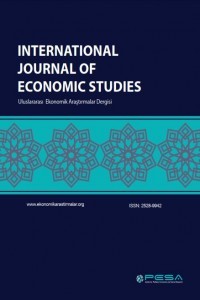Tüketimin Ekonomik Temelleri ve Türkiye’deki Bileşenleri
Bireyler, ihtiyaçlarını karşılamak maksadıyla mal ve hizmetleri nihai olarak kullanarak tüketirler. Günümüzde toplumun değişen yapısıyla tüketimin millî gelir içindeki payı artma eğilimindedir. Sürdürülebilir bir büyüme için tüketimin kontrol edilmesi son derece önemlidir. Bu kapsamda, tüketimin teorik temelleri ve teorinin ekonometrik olarak geçerliliğinin araştırılması için birçok çalışma yapılmıştır. Keynes tarafından ortaya konulan marjinal tüketim eğilimi, Kalıcı Gelir ve Yaşam Boyu Tüketim bu konudaki temel çalışmalardandır. Ancak yapılan ampirik çalışmalarda teorilerin geçerliliği tam olarak ortaya konulamamıştır. Türkiye’nin çok uzun yıllardır en büyük sorunu, yeterli sermaye ve bunu sağlayacak olan tasarruf oranlarına erişilememesi olmuştur. Tüketimin temel bileşenlerinin bilinmesi ekonomik politikaların oluşturulmasında son derece önemlidir. Kullanılacak verilerin zaman serisi olması nedeniyle öncelikle birim kökün varlığı araştırılmış ve Eşbütünleştirme Metodu ile model oluşturulmuştur. Yapılmış olan çalışmada etkisi en yüksek olan değişkenlerin sabit değişken ve GSMH’daki değişim olduğu görülmüştür. Elde edilen ekonometrik sonuçlar teorilere paralel olarak tüketimin GSMH’ya oranın uzun dönemde değişiminin çok az olduğunu desteklemiştir.
Anahtar Kelimeler:
Tüketim, Gelir, Eşbütünleştirme
Consumption Economic Bases and Components in Turkey
Individuals consume goods and services ultimately to meet their needs. Today, the share of consumption in national income tends to increase with the changing structure of society. Control of consumption for sustainable growth is crucial. In this context, many studies have been carried out to investigate econometric validity of theoretical foundations and theory of consumption. The marginal propensity to consume by Keynes, Permanent Income and Lifetime Consumption is the main work in this area. However, the validity of the theories in the empirical studies was not fully revealed. For many years, Turkey's biggest problem has been the inability to reach adequate capital and the saving rates that it will provide. Knowing the basic components of consumption is crucial in the formation of economic policies. Due to the fact that the data to be used is a time series, the entity's root entity was researched and modeled by the Cointegration Method. It is seen that the variables with the highest effect are changes in fixed variable and GNP. The econometric results obtained support the fact that, in parallel with the theories, there is very little change in the ratio of consumption to GNP in the long run
Keywords:
Consumption, Income, Cointegration.,
___
- Agénor, P.R. ve Peter, J.M. (2008) “Development Macroeconomics”, 3rd Ed., Princeton University Press, 63.
- Barro, R.J. ve Xavier, S. M. (2004) “Economic Growth”, 2nd Ed., The MIT Press, 35.
- Bhattacharya ve Mukherjee, S. (2010) “Private Sector Consumption and Government Consumption and Debt in Advanced Economies: An Empirical Study”, IMF Working Paper: 20.
- Blanchard, O.J. ve Stanley, F. (1989) “Lectures on Macroeconomics”, The MIT Press, 41.
- Bouakez, H. ve Rebei, N. (2003) “Why Does Private Consumption Rise After a Government Spending Shock?”, Bank of Canada Working Paper: 19-20.
- Campbell, J.Y. ve Mankiw, N.G. (1989) “Consumption, Income and Interest Rates: Reinterpreting the Time Series Evidence”, NBER Macroeconomics Annual 1989, Volume 4, http://www.nber.org/books/blan89-1, 210: 185-246.
- Case, K.E., Ray, C.F. ve Sharon, M.O. (2012) “Principles of Macroeconomics”, 10th Ed., Prentice Hall: 304.
- Časni, A. (2014) “Housing Wealth Effect on Personal Consumption: Empirical Evidence from European Post-Transition Economies”, Finance a şvěr-Czech Journal of Economics and Finance, 64, No. 5: 392-406.
- Cerrato, M., Peretti, C. ve Stewart, C. (2013) “Is the consumption-income ratio stationary? Evidence from linear and nonlinear panel unit root tests for OECD and non-OECD countries”, http://www.gla.ac.uk/media/media_95523_en.pdf, 10. Manchester School Vol. 81, Issue 1
- Davidson, R. ve MacKinnon, J.G. (1999) “Foundations of Econometrics”, Oxford Press: 595.
- Deaton, A. (2015) “Consumption, Poverty And Welfare, The Royal Swedish Academy of Sciences”:16.
- Friedman, M. (1957) “A Theory of the Consumption Function”, Princeton Universitiy Press, http://www.nber.org/books/frie57-1: 222.
- Hall, R.E. (1987) “Consumption”, NBER Working Paper, http://www.nber.org/chapters/c2265: 1-30.
- Helmut, L. ve Kratzig, M. (2004) “Applied Time Series Econometrics”, Cambridge Unv Press: 54.
- Johansen, S. (2014) “Times Series: Cointegration”, Department of Economics and Business Aarhus University,http://econpapers.repec.org/paper/aahcreate/2014-38.htm : 4.
- Keynes, J.M. (2011) “The General Theory of Employment, Interest, and Money”, http://cas.umkc.edu/ economics/people/facultypages/kregel/courses/econ645/winter2011/generaltheory.p df: 1-273.
- Mankiw, N.G. (2010) “Macroeconomics”, 7th ed., Harvard University.
- Mei, Y. (2012) “Is Consumption in the United States Influenced by Income Inequality? A Cointegration Analysis”, Issues in Political Economy, Vol 21, 40: 31-45.
- Modigliani, F. (1985) “Life Cycle, Individual Thrift and The Wealth Of Nations”, Economic Sciences, Vol. 76, No. 3,300: 297-313.
- Obstfeld, M. ve Kenneth, R. (1996) “Foundations of the International Macroeconomics”, the MIT Press.
- Özer, Y.B. ve Kam, K.T. “An Empirical Analysis of Financial and Housing Wealth Effects on Consumption in Turkey”, MRG Discussion Paper Series, 2809, School of Economics, University http://www.uq.edu.au/economics/mrg/2809.pdf, 17:1-36. of Queensland, Australia
- Romer, D. (1996) “Advanced Macroeconomics”, McGraw Hill Company: 317.
- Zeldes, S.P. (1989) “Optimal Consumption with Stochastic Income: Deviations from Certainty Equivalence, The Quarterly of Economics”: 275-298.
- ISSN: 2528-9942
- Başlangıç: 2015
- Yayıncı: Politik Ekonomik ve Sosyal Araştırmalar Merkezi
Sayıdaki Diğer Makaleler
Arap Baharı Olaylarının Orta Doğu Ekonomilerine Etkileri
Mine IŞIK, Özlem ÖZTÜRK ÇETENAK
Tüketimin Ekonomik Temelleri ve Türkiye’deki Bileşenleri
Foreign Direct Investments and Economic Freedom in OECD Countries
Türkiye’de Günah Vergileri Kapsamında Özel Tüketim Vergisi Uygulaması ve Etkinliği
